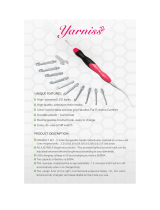
English
5
(6) Use safety equipment. Always wear eye
protection.
Dust mask, non-skid safety shoes, hard hat,
or hearing protection must be used for
appropriate conditions.
4. Tool Use and Care
(1) Use clamps or other practical way to secure
and support the workpiece to a stable
platform.
Holding the work by hand or against your
body is unstable and may lead to loss of
control.
(2) Do not force tool. Use the correct tool for your
application.
The correct tool will do the job better and safer
at the rate for which it is designed.
(3) Do not use tool if switch does not turn it on
or off.
Any tool that cannot be controlled with the
switch is dangerous and must be repaired.
(4) Disconnect battery pack from tool or place
the switch in the locked or off position before
making any adjustments, changing
accessories, or storing the tools.
Such preventive safety measures reduce the
risk of starting the tool accidentally.
(5) Store idle tools out of reach of children and
other untrained persons.
Tools are dangerous in the hands of untrained
users.
(6) When battery pack is not in use, keep it away
from other metal objects like: paper clips,
coins, keys, nails, screws, or other small
metal objects that can make a connection
from one terminal to another.
Shorting the battery terminals together may
cause sparks, burns, or a fire.
(7) Maintain tools with care. Keep cutting tools
sharp and clean.
Properly maintained tools, with sharp cutting
edges are less likely to bind and are easier to
control.
(8) Check for misalignment or binding of moving
parts, breakage of parts, and any other
condition that may affect the tools operation.
If damaged, have the tool serviced before
using.
Many accidents are caused by poorly
maintained tools.
(9) Use only accessories that are recommended
by the manufacturer for your model.
Accessories that may be suitable for one tool,
may become hazardous when used on
another tool.
5. Service
(1) Tool service must be performed only by
qualified repair personnel.
Service or maintenance performed by
unqualified personnel could result in a risk of
injury.
(2) When servicing a tool, use only identical
replacement parts. Follow instructions in the
Maintenance section of this manual.
Use of unauthorized parts or failure to follow
Maintenance Instruction may create a risk of
electric shock or injury.
WARNING:
Some dust created by power sanding, sawing,
grinding, drilling, and other construction activities
contains chemicals known to the State of California
to cause cancer, birth defects or other reproductive
harm. Some examples of these chemicals are:
●
Lead from lead-based paints,
●
Crystalline silica from bricks and cement and other
masonry products, and
●
Arsenic and chromium from chemically-treated
lumber.
Your risk from these exposures varies, depending
on how often you do this type of work. To reduce
your exposure to these chemicals: work in a well
ventilated area, and work with approved safety
equipment, such as those dust masks that are
specially designed to filter out microscopic particles.
SPECIFIC SAFETY RULES AND SYMBOLS
1. Hold tools by insulated gripping surfaces when
performing an operation where the cutting tool
may contact hidden wiring.
Contact with a “live” wire will make exposed metal
parts of the tool “live” and shock the operator.
2. ALWAYS wear ear protectors when using the tool
for extended periods.
Prolonged exposure to high intensity
noise can cause hearing loss.
3. NEVER place hands or other body parts near the
drill bit or chuck during operation. Hold the drill
by its handle only.
4. Because the cordless driver drill operates by
battery power, be aware of the fact that it can begin
to operate at any time.
5. When working at elevated locations, clear the area
of all other people and be aware of conditions
below you.
6. NEVER touch moving parts.
NEVER place your hands, fingers or other body
parts near the tool’s moving parts.
7. NEVER operate without all guards in place.
NEVER operate this tool without all guards or
safety features in place and in proper working
order. If maintenance or servicing requires the
removal of a guard or safety feature, be sure to
replace the guard or safety feature before resuming
operation of the tool.
01Eng_DS12DVF3_US 12/6/07, 11:365




















